De Dietrich MS 24 BIC FF – страница 4
Инструкция к Водонагревателю De Dietrich MS 24 BIC FF
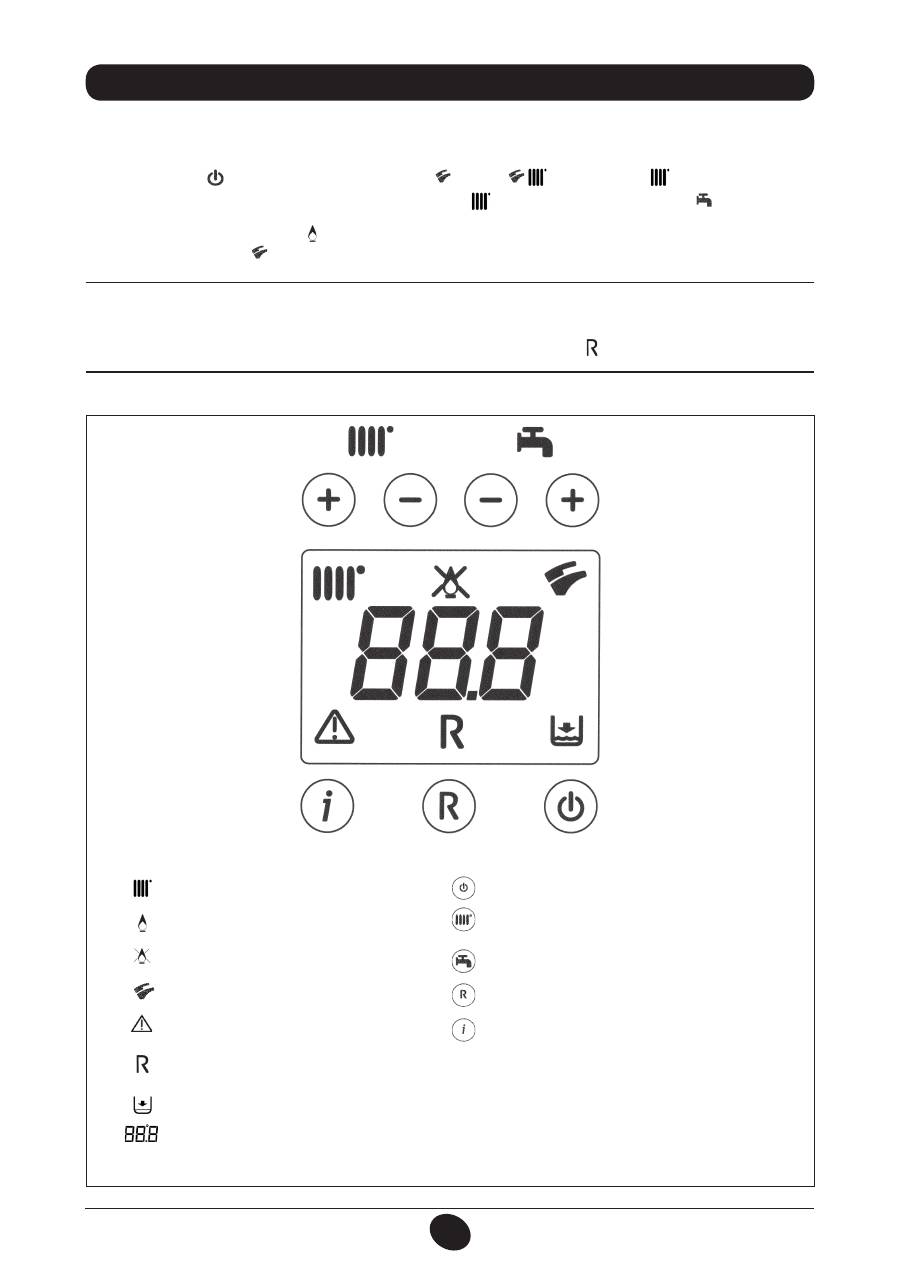
61
71.06199.02 - EN
OPERATING INSTRUCTIONS
To light the boiler correctly, proceed as follows:
1) power the boiler
2) open the gas tap;
3) press the button (
)
and switch the boiler to Summer ( ), Winter (
) or heating only (
);
4) press the heating circuit (
+/-
) and domestic hot water circuit (
) temperature adjustment buttons ( ) in order to ignite
the main burner.
When the boiler is lit, the symbol ( ) will appear on the display.
In the Summer position ( ) the main burner will only ignite if a DHW tap is opened.
WARNING
During initial ignition, the burner may not ignite (causing the boiler to shut down) until any air in the gas pipes is vented. In
this case, repeat the ignition procedure until gas reaches the burner. Press button ( ), for at least 2 seconds.
3. COMMISSIONING THE BOILER
Operation in the heating mode
Flame present (burner on)
No flame (ignition failure)
Operation in the DHW mode
Generic fault
No water (Low system pressure)
Numerical signal (Temperature, fault code, etc.)
RESET
BUTTON KEY
Figure 1
SYMBOL KEY
On / Off / Summer / Winter / heating only
(
+/-
) : CH temperature adjustment
(
+/-
) : DHW temperature adjustment
Reset
Information
0805_2302 / C
G_2072
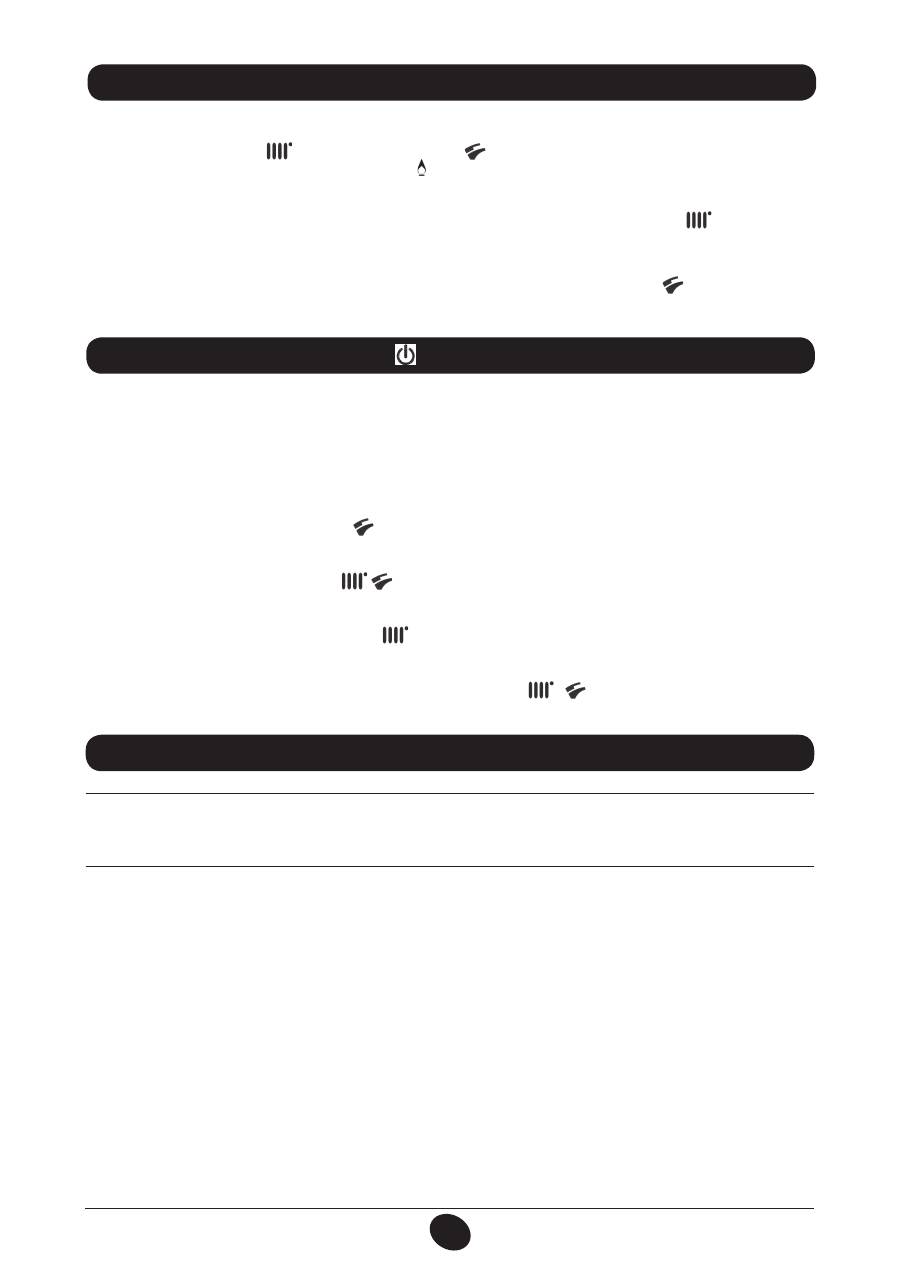
62
71.06199.02 - EN
OPERATING INSTRUCTIONS
4. ADJUSTING ROOM TEMPERATURE AND DHW TEMPERATURE
The system must be fitted with a room thermostat for controlling indoor temperature.
Adjust the room temperature (
) and the DHW temperature (
) by pressing the respective
+/-
(figure 1). The ignition
of the burner is shown on the display with the symbol ( ) as described in section 3.
HEATING
While the boiler is operating in the heating mode, the display (figure 1) shows the flashing symbol (
) and the heating
delivery temperature (°C).
DOMESTIC HOT WATER
While the boiler is operating in the DHW mode, the display (figure 1) shows the flashing symbol (
) and the DHW output
temperature (°C).
Press this button to set the following operating modes:
• SUMMER
• WINTER
• HEATING ONLY
• OFF
In the
SUMMER
mode, the display shows (
). The boiler satisfies requests for DHW only while central heating is NOT
enabled (ambient frost protection function active).
In the
WINTER
mode, the display shows (
). The boiler satisfies requests for both DHW and central heating (am-
bient frost protection function active).
In the
HEATING ONLY
mode, the display shows (
). The boiler satisfies requests for central heating only (ambient frost
protection function active).
In the
OFF
mode, the display shows neither of the above two symbols (
) (
). In this mode, only the ambient frost
protection function is active while requests for DHW and central heating are not satisfied.
5. DESCRIPTION OF BUTTON (Summer - Winter - Heating only - Off)
WARNING
Disconnect the boiler from the mains power supply using the two-pole switch.
IMPORTANT:
Regularly check that the pressure displayed on the pressure gauge is 0.7 - 1.5 bar, with the boiler cold.
In case of overpressure, open the boiler drain tap. In case of insufficient temperature, open the boiler filling tap (figure 3).
Open the tap very slowly in order to vent the air.
6. FILLING THE SYSTEM
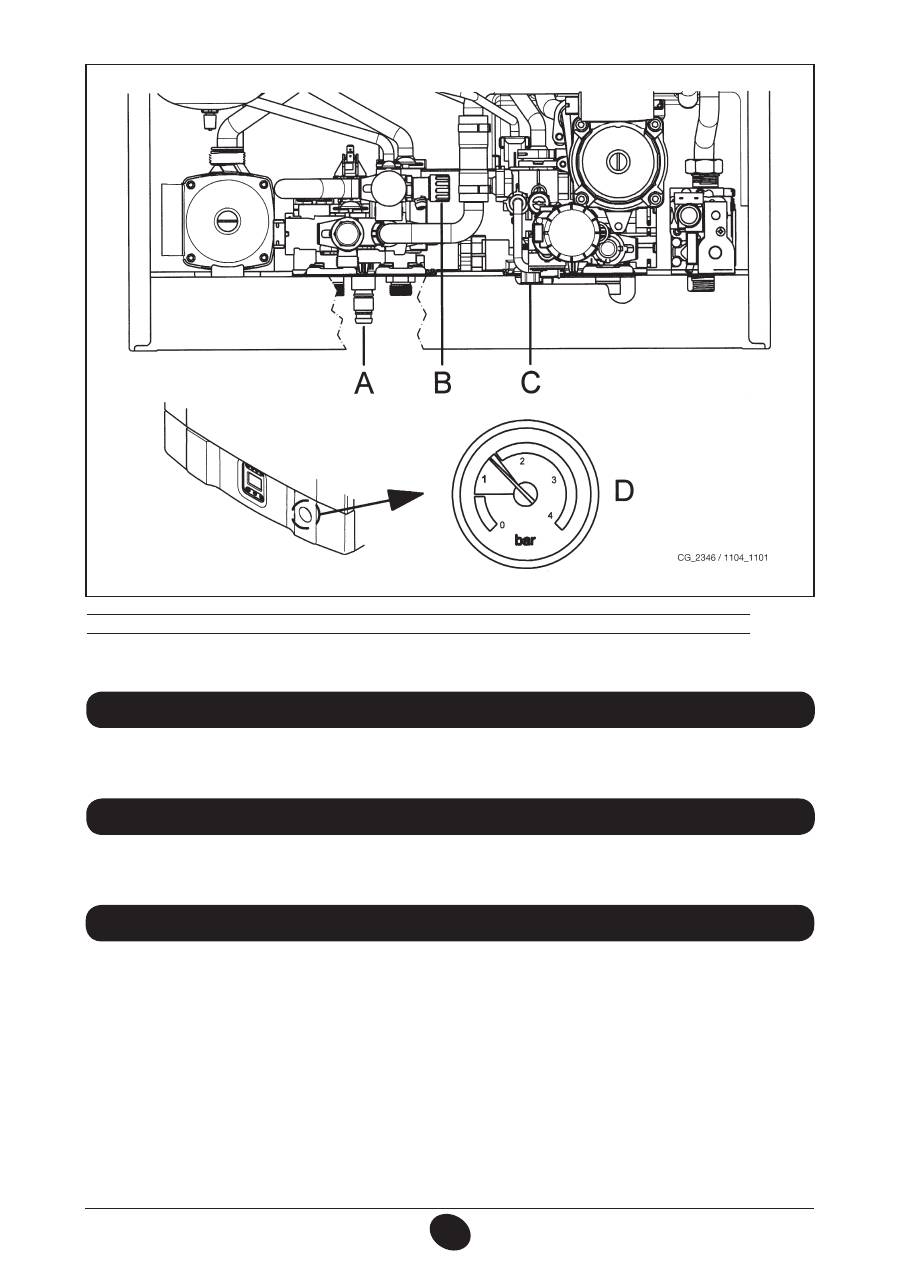
63
71.06199.02 - EN
OPERATING INSTRUCTIONS
To turn off the boiler, disconnect the electric power supply. In “OFF” mode (section 5) the boiler remains off (the display
indicates OFF) though the electrical circuits remain live and the frost protection device is enabled (section 9).
7. TURNING OFF THE BOILER 8. GAS CONVERSION
The boilers can operate both on natural gas and
LPG
.
All gas conversions must be made by an authorised Service Engineer.
The boiler is fitted with a hydraulic pressure gauge which prevents the boiler from working if there is no water.
N.B.:
In case pressure drops occur frequently, have the boiler checked by an authorised Service Engineer.
A:
System emptying tap
B:
Boiler emptying tap
C:
System filling tap
D:
Pressure gauge
Figure 2
Do not drain the whole system as filling up with water again causes unnecessary and harmful scale to build up inside the
boiler and the heating elements. If the boiler is not used during winter and is therefore exposed to the danger of frost, add
some specific anti-freeze to the water in the system (e.g.: propylene glycol coupled with corrosion and scale inhibitors).
The electronic boiler management system includes a “frost protection” function for the heating system which, when delivery
temperature falls below 5°C, operates the burner until a delivery temperature of 30°C is reached.
The frost protection function is enabled if:
* the boiler is electrically powered;
* the gas tap is open;
* the system is at the correct pressure;
* the boiler is not blocked.
9. PROLONGED SHUTDOWN. FROST PROTECTION

64
71.06199.02 - EN
OPERATING INSTRUCTIONS
10. TROUBLESHOOTING
N.B.:
in case of a fault, the display backlighting flashes together with the error code.
To keep the boiler efficient and safe, have it checked by the authorised Service Centre at the end of every operating period.
Careful servicing ensures economical operation of the system.
Do not clean the outer casing of the appliance with abrasive, aggressive and/or easily flammable cleaners (e.g.: petrol,
alcohol, and so on). Always switch off the appliance before cleaning it (see section 7 Switching off the boiler).
11. ROUTINE MAINTENANCE INSTRUCTIONS
Faults are shown on the display with an error code (e.g.: E 01):
CODE
DISPLAYED
FAULT
CORRECTIVE ACTION
E01
Failed ignition shutdown
Press and hold down “
R
” for at least 2 seconds. If this fault persists, call the
Authorised Service Centre.
E02
Safety thermostat tripped
Press and hold down “
R
” for at least 2 seconds. If this fault persists, call the
Authorised Service Centre.
E03
Flue thermostat/ flue pressure
switch tripped
Call the Authorised Service Centre.
E04
Shutdown after 6 consecutive
flame losses
Press and hold down “
R
” for at least 2 seconds. If this fault persists, call the
Authorised Service Centre.
E05
Flow sensor failure
Call the Authorised Service Centre.
E06
DHW sensor fault
Call the Authorised Service Centre.
E10
Hydraulic pressure switch
block
Check that the pressure in the system is correct; See section 6. If this fault
persists, call the Authorised Service Centre.
E25/E26
Probable blocked pump safety
trip
Call the Authorised Service Centre.
E35
Parasite flame (flame error)
Press and hold down “
R
” for at least 2 seconds. If this fault persists, call the
Authorised Service Centre.
E96
Switching off due to reductions
in power supply
RESET is automatic. If this fault persists, call the Authorised Service Centre
To RESET the boiler, press and hold down “R” for at
least 2 seconds. If this fault persists, call the Authorised
Service Centre.
N.B.:
5 reset attempts can be performed after which
the boiler shuts down. To reset again, switch off the
boiler for a few seconds.
Figure 3
0607_1205
RESETTABLE
faults

65
71.06199.02 - EN
INSTALLATION INSTRUCTIONS
The following notes and instructions are addressed to fitters to allow them to carry out trouble-free installation. Instructions
for igniting and using the boiler are contained in the ‘Instructions for Users’ section.
• This boiler can be connected to any type of double- or single-pipe convector plate, radiator or thermoconvector. Design
the system sections as usual, though, bearing in mind the available flow-head at the plate, as shown in section 25.
• Do not leave any packaging (plastic bags, polystyrene, etc.) within reach of children, as it is a potential source of danger.
• Initial lighting of the boiler must be carried out by an authorised Service Engineer, as indicated on the attached sheet.
Failure to observe the above will render the guarantee null and void.
ADDITIONAL PUMP WARNING
If an additional pump is used on the heating system, position it on the boiler return circuit. This will allow the correct
operation of the water pressure switch.
SOLAR WARNING
if the instantaneous (mixed) boiler is connected to a system with solar panels, the maximum temperature of the domestic
hot water entering the boiler must not exceed
60°C
.
12. GENERAL INFORMATION
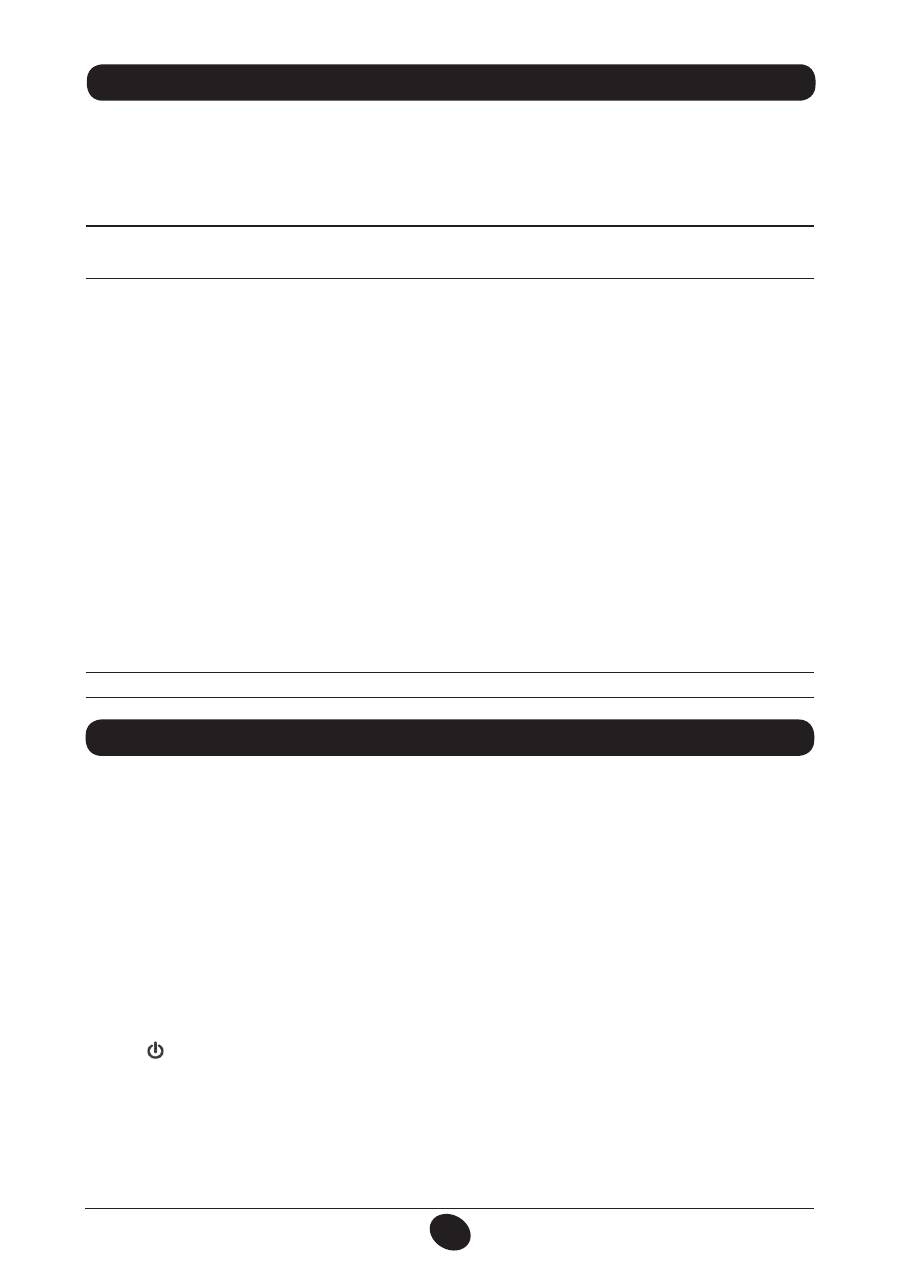
66
71.06199.02 - EN
INSTALLATION INSTRUCTIONS
This boiler has been designed to heat water to a temperature lower than boiling point at atmospheric pressure.
It must be connected to a central heating system and to a domestic hot water supply system according to its performance
and power output.
Do the following before connecting the boiler:
a) Make sure that the boiler is adjusted to use the type of gas delivered by the gas supply. To do this, check the markings
on the packaging and the rating plate on the appliance.
b) Make sure that the flue terminal draft is appropriate, that the terminal is not obstructed and that no exhaust gases
from other appliances are expelled through the same flue duct, unless the latter has been specially designed to collect
exhaust gas from more than one appliance, in compliance with current laws and regulations.
c) Make sure that, if the boiler is connected to existing flue ducts, these have been thoroughly cleaned as residual products
of combustion may detach from the walls during operation and obstruct the flow of fumes.
To ensure correct operation and maintain the warranty, observe the following precautions:
1. DHW circuit:
1.1.
If the water is harder than 20 °F (1 °F = 10 mg calcium carbonate per litre of water), install a polyphosphate dispenser
or an equivalent treatment system, compliant with current regulations.
1.2.
Thoroughly flush the system after installation of the appliance and before use.
1.3.
The materials used for the product’s DHW circuit comply with Directive 98/83/CE.
2. Heating circuit
2.1. new system
Before proceeding with installation of the boiler, the system must be cleaned and flushed to eliminate residual
thread-cutting swarf, solder and any solvents, using suitable proprietary products. To avoid damaging metal, plastic
and rubber parts, only use neutral cleaners, i.e. non-acid and non alkaline. Recommended cleaning products are:
SENTINEL X300 or X400 and FERNOX Regenerator for heating circuits. Use these products in strict compliance
with the manufacturers’ instructions.
2.2. existing system:
Before installing the boiler, drain the system and clean it to remove sludge and contaminants, using suitable
proprietary products as described in section 2.1.
To avoid damaging metal, plastic and rubber parts, use only neutral cleaners, i.e. non-acid and non-alkaline such
as SENTINEL X100 and FERNOX Protector for heating circuits. Use these products in strict compliance with the
manufacturers’ instructions.
Remember that the presence of foreign bodies in the heating system can adversely affect boiler operation (e.g.
overheating and excessive noise of the heat exchanger).
Failure to observe the above will render the warranty null and void
.
13. INSTRUCTIONS PRIOR TO INSTALLATION 13. INSTALLAZIONE DELLA CALDAIA 14. INSTALLING THE BOILER
After deciding the exact location of the boiler, make sure there is sufficient room to perform maintenance operations (at
least 450 mm of headroom is required in order to replace the expansion vessel).
Connect the system to the gas and water inlets present on the lower bar of the template. Fit two G3/4 taps (flow and
return) on the central heating circuit; these taps make it possible to carry out important operations on the system without
draining it completely. If you are either installing the boiler on an existing system or replacing one, as well as the above,
fit a settling tank under the boiler on the system return line in order to collect any deposits and scale circulating in the
system after flushing. After fixing the boiler to the template, connect the flue and air ducts, supplied as accessories, as
described in the following sections.
If the model
24 BIC
natural draught boiler is installed, connected it to the flue with a metal pipe resistant to normal me-
chanical stress, heat, products of combustion and relative condensate.
IMPORTANT
After filling the boiler, vent the entire internal circuit and the system as follows:
• close the gas on-off valve;
• power the boiler.
• open the vent valve on the pump body;
• press (
) to set the boiler in the “WINTER” operating mode;
• send a heat demand from the room thermostat;
• open a hot water tap to alternate CH demand with DHW demand;
• after a few ignition attempts the boiler will shut down (error E01 appears on the display);
• to rest, press and hold down “
R
” for at least 2 seconds;
• repeat the procedure at least another two times;
• close the vent valve.
After venting the boiler circuit, proceed with initial lighting.
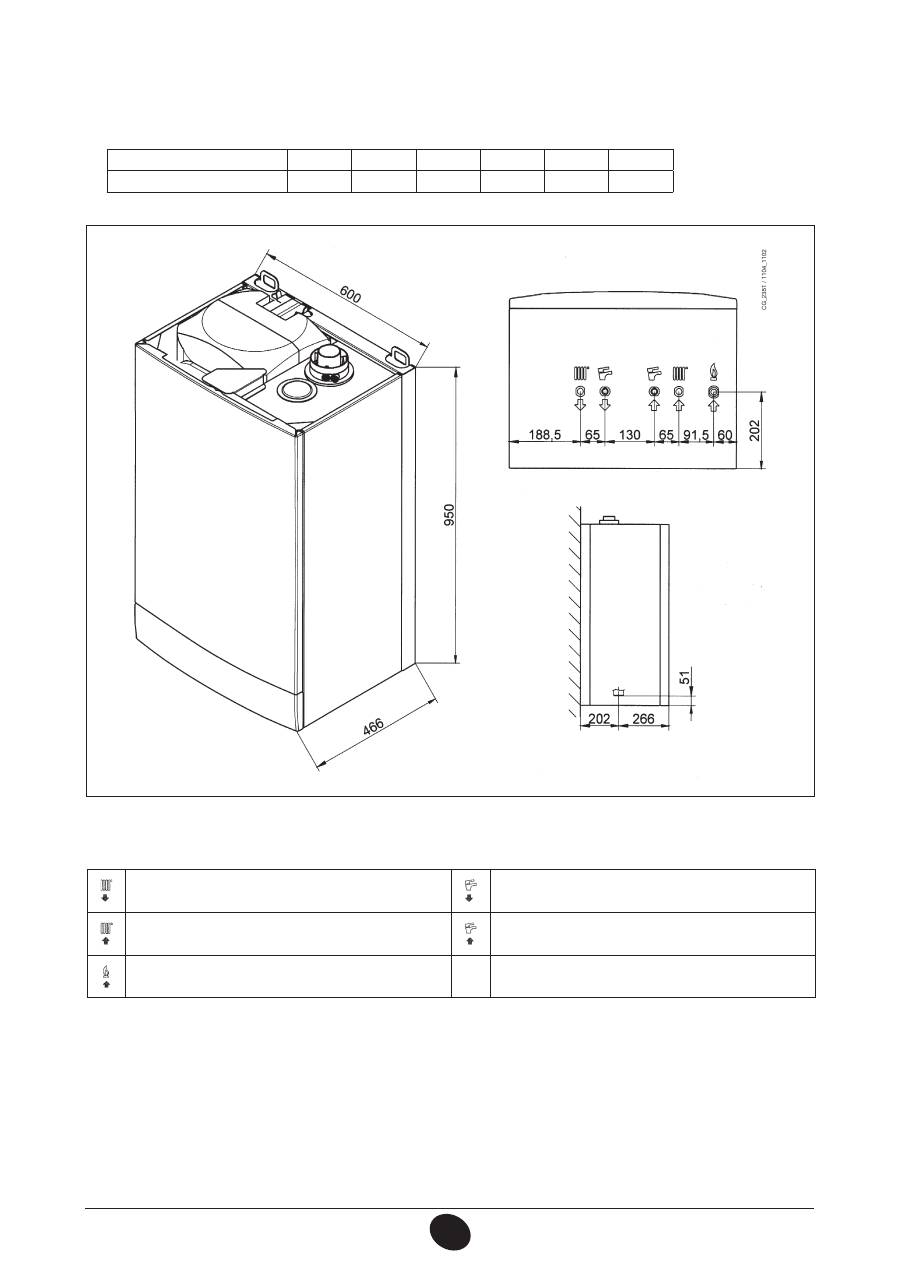
67
71.06199.02 - EN
INSTALLATION INSTRUCTIONS
EXPANSION VESSEL
The boiler features a standard 7.5-litre expansion vessel with a pre-charge pressure of 1 bar. The maximum volume of water in
the system is calculated according to hydrostatic pressure at an average water temperature of 80°C (flow: 95°C return: 75°C).
Hydrostatic pressure (m)
5
6
7
8
9
10
Maximum system volume (l)
138
131
119
107
97
87
G”3/4 HEATING FLOW
G”1/2 DOMESTIC HOT WATER OUTLET
G”3/4 HEATING RETURN
G”1/2 DOMESTIC COLD WATER INLET
G”3/4 GAS INLET TO BOILER
WARNING
Tighten the boiler nipple water connections with care (maximum tightening torque 30 Nm).
Figure 4
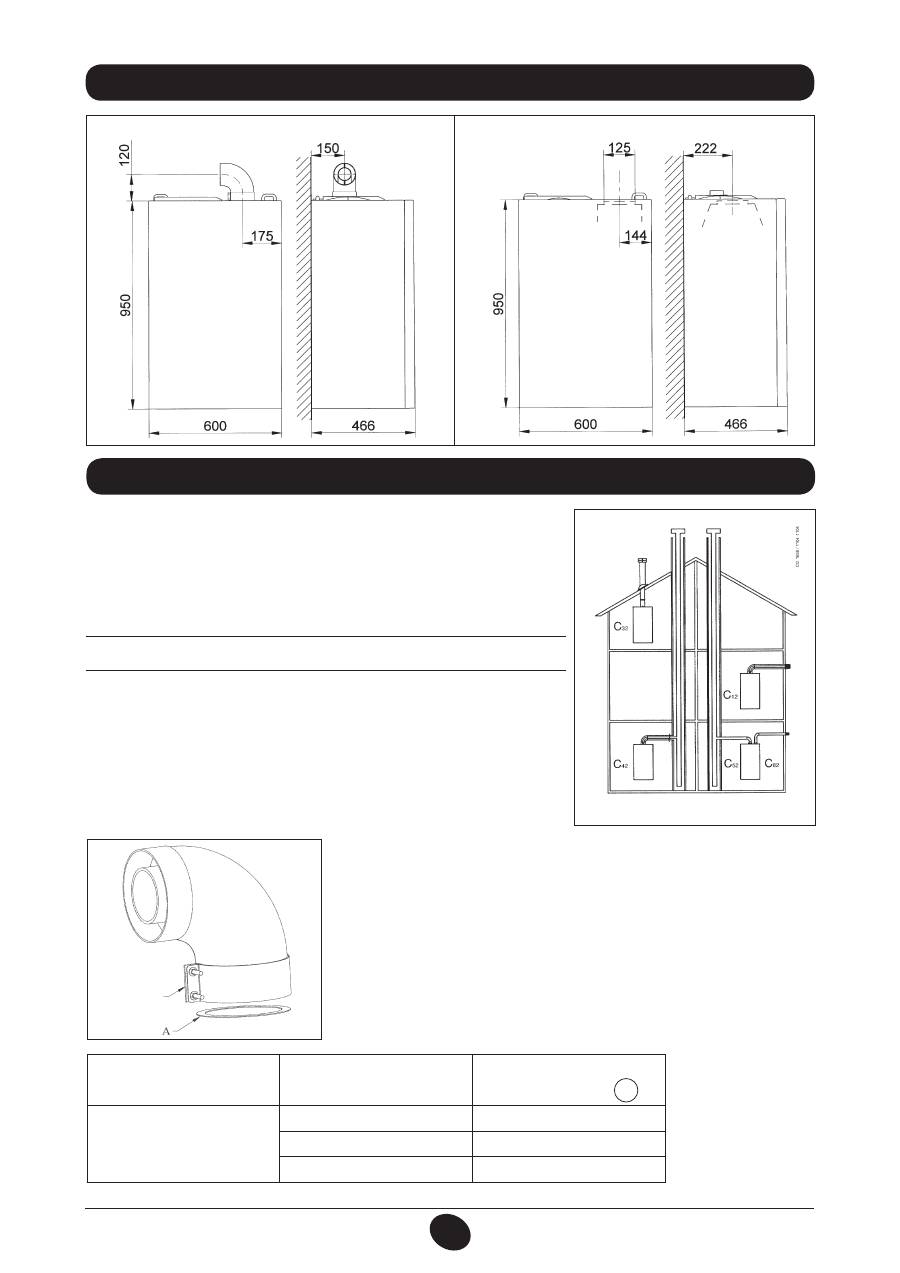
68
71.06199.02 - EN
INSTALLATION INSTRUCTIONS
14. DIMENSIONI CALDAIA 15. DIMENSIONS OF BOILER
Figure 5
24 BIC FF
24 BIC
CG_1848 / 1104_0702
CG_1848 / 1104_0703
16. INSTALLING THE FLUE AND AIR DUCTS
Boiler model
Length (m)
Use of DIAPHRAGM
on INLET LINE
A
24 BIC FF
0,5
73
0,5 ÷ 2
80
2 ÷ 4
No
If fumes are discharged outside the building, the flue-air duct must protrude
at least 18 mm from the wall to allow an aluminium weathering surround to be
fitted and sealed to avoid water infiltrations.
Make sure there is a minimum upward slope towards the outside of 1 cm per
metre of duct.
•
A 90° curve reduces total duct length by 1 metre.
•
A 45° curve reduces total duct length by 0.5 metres.
The first 90° curve is not considered when calculating the maximum avai-
lable length.
Figure 7
Connector
0805_2901 / C
G_2073
Model 24 BIC FF
The boiler is easy and flexible to install thanks to the extensive range of available
accessories, as described below.
The boiler has been designed for connection to a vertical or horizontal coaxial
flue-air duct. A splitting kit is also available if separate ducts are required.
Only accessories supplied by the manufacturer must be used for installation!
WARNING: To optimise operating safety, make sure the flue ducts are firmly
fixed to the wall with suitable brackets.
… COAXIAL FLUE-AIR DUCT (CONCENTRIC)
This type of duct is used to discharge exhaust fumes and draw combustion air
both outside the building and if a LAS flue is fitted.
The 90° coaxial curve allows the boiler to be connected to a flue-air duct in any
direction as it can be rotated by 360°. It can also be used as a supplementary
curve combined with a coaxial duct or a 45° curve.
Figure 6
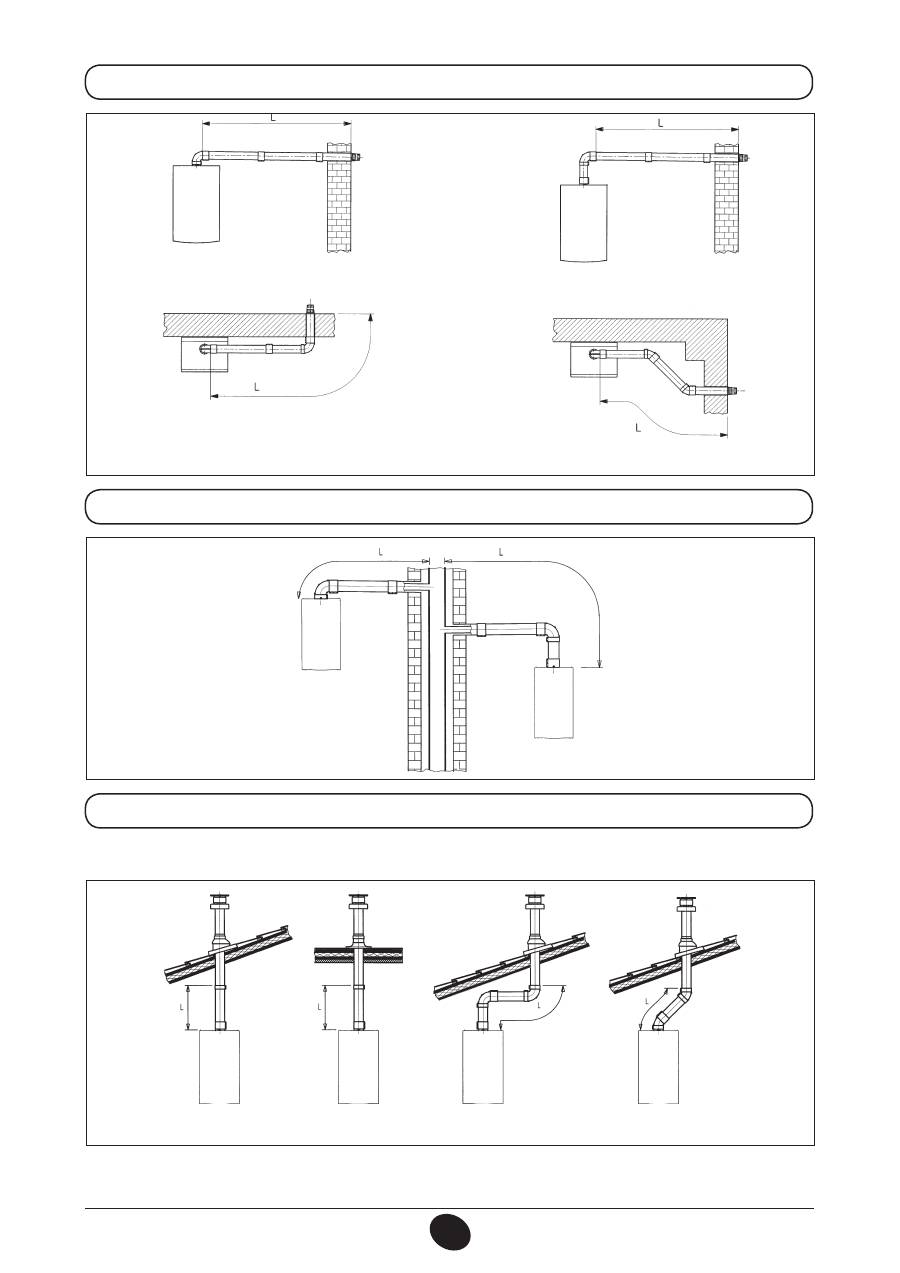
69
71.06199.02 - EN
INSTALLATION INSTRUCTIONS
16.1 HORIZONTAL FLUE INSTALLATION EXAMPLES
16.2 LAS FLUE DUCT INSTALLATION EXAMPLES C42 TYPE
16.3 VERTICAL FLUE INSTALLATION EXAMPLES
This type of installation can be carried out on either a flat or a pitched roof by fitting a flue terminal and a special weathering
surround with sleeve (both available on request).
0503_0908/CG1641
0512_2001
For detailed installation instructions, consult the technical data provided with the accessories.
0503_0907/CG1640
L max = 10 m (Ø 80/125 mm)
L max = 4 m (Ø 60/100 mm)
8 m (Ø 80/125 mm)
L max = 4 m (Ø 60/100 mm)
8 m (Ø 80/125 mm)
L max = 4 m (Ø 60/100 mm)
8 m (Ø 80/125 mm)
L max = 3 m (Ø 60/100 mm)
7 m (Ø 80/125 mm)
L max = 3 m (Ø 60/100 mm)
7 m (Ø 80/125 mm)
L max = 8 m (Ø 80/125 mm)
L max = 9 m (Ø 80/125 mm)
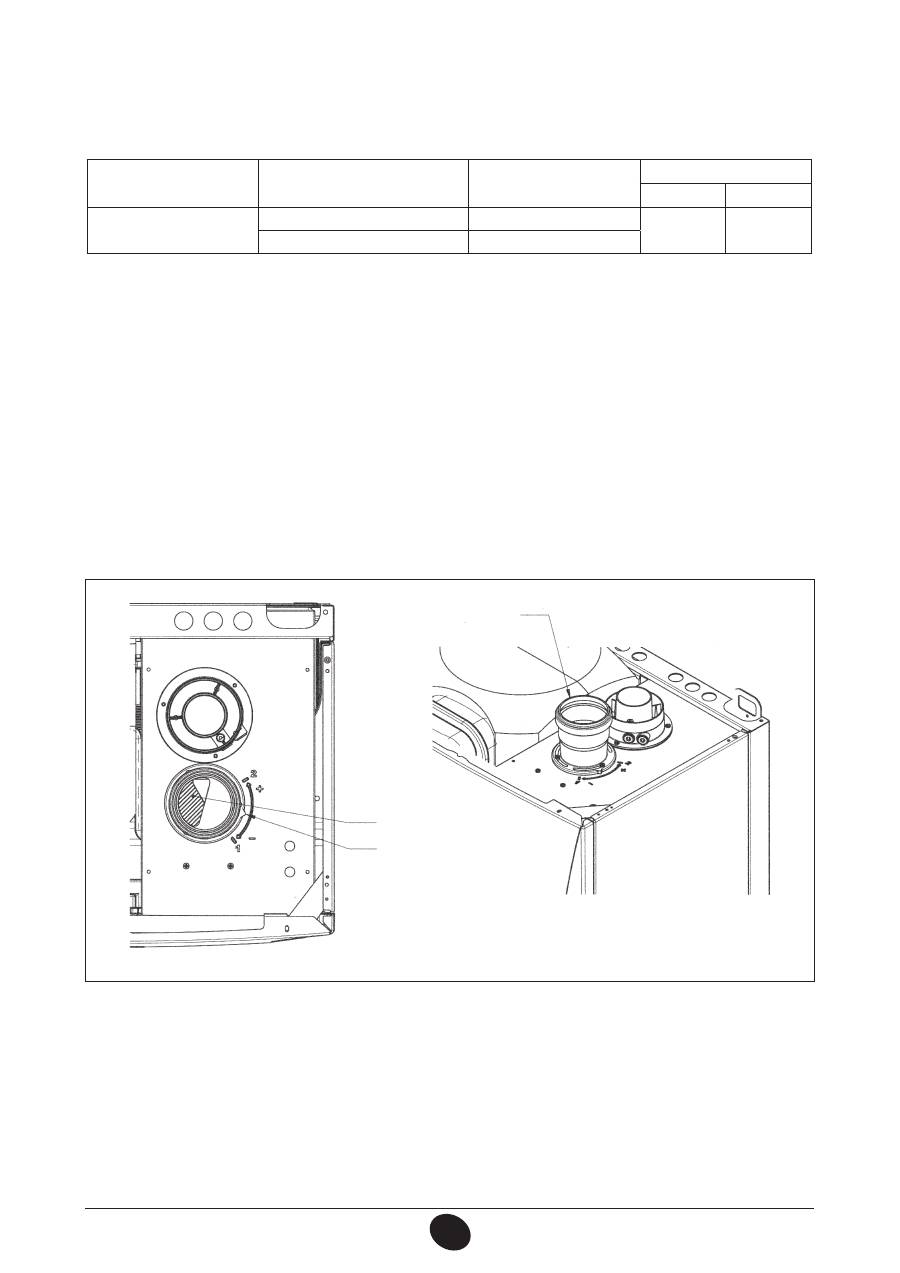
70
71.06199.02 - EN
INSTALLATION INSTRUCTIONS
… SEPARATE FLUE AND AIR DUCTS
This type of installation makes it possible to discharge exhaust fumes both outside the building and into single flue ducts.
Comburent air can be drawn in at a different location from that of the flue terminal. The splitting kit comprises a flue duct
adaptor (100/80) and an air duct adaptor. For the air duct adaptor, fit the screws and seals previously removed from the cap.
The 90° curve allows the boiler to be connected to a flue-air duct in any direction as it can be rotated by 360°. It can also
be used as a supplementary curve combined with a duct or a 45° curve.
• A 90° curve reduces total duct length by 0.5 metres.
• A 45° curve reduces total duct length by 0.25 metres.
The first 90° curve is not considered when calculating the maximum available length.
Boiler model
(L1+L2)
Position
of air regulator
CO
2
%
G20
G31
24 BIC FF
0 ÷ 20
1
6,1
8,7
20 ÷ 30
2
Adjusting the air regulator for separate flues
This regulator must be adjusted to optimise combustion efficiency and parameters.
After turning the air intake connecter, which can be mounted both to the right and the left of the exhaust flue duct, suitably
adjust the excess air according to the total length of the combustion exhaust and inlet flue ducts.
Turn this regulator anticlockwise to decrease the excess of comburent air and vice-versa to increase it.
To fine tune, use a combustion product analyser to measure the amount of CO
2
in the fumes at maximum heat capacity,
and, if a lower value is measured, gradually adjust the air regulator until the amount of CO
2
indicated in the following table
is measured.
To mount this device correctly, consult the relative instructions.
Figure 8
CG_1145 / 1104_0801
connector
aperture
index

71
71.06199.02 - EN
INSTALLATION INSTRUCTIONS
16.5 HORIZONTAL SEPARATE FLUE INSTALLATION EXAMPLES - C82
IMPORTANT
-
Make sure there is a minimum downward slope towards the outside of 1 cm per metre of duct length.
In the event of installation of the condensate collection kit, the angle of the drain duct must be directed towards the boiler.
N.B.:
For the C52 type, do not fit the flue and air duct terminals on opposite walls of the building.
The inlet flue must have a maximum length of 10 metres for C52 fumes outlets.
If the discharge duct is longer than 6 metres, install the condensate collection kit, supplied as an accessory, near the boiler
16.4 DIMENSIONS OF SEPARATE OUTLETS
L max = 10 m
(L1 + L2) max = 30 m
1010_0102/CG1643
CG_1643_FR / 1010_0101
IMPORTANT:
if fitting a single flue duct, make sure it is adequately insulated (e.g.: with glass wool) wherever the duct
passes through building walls. For detailed installation instructions, consult the technical data provided with the accessories.
CG_2344 / 1103_3002
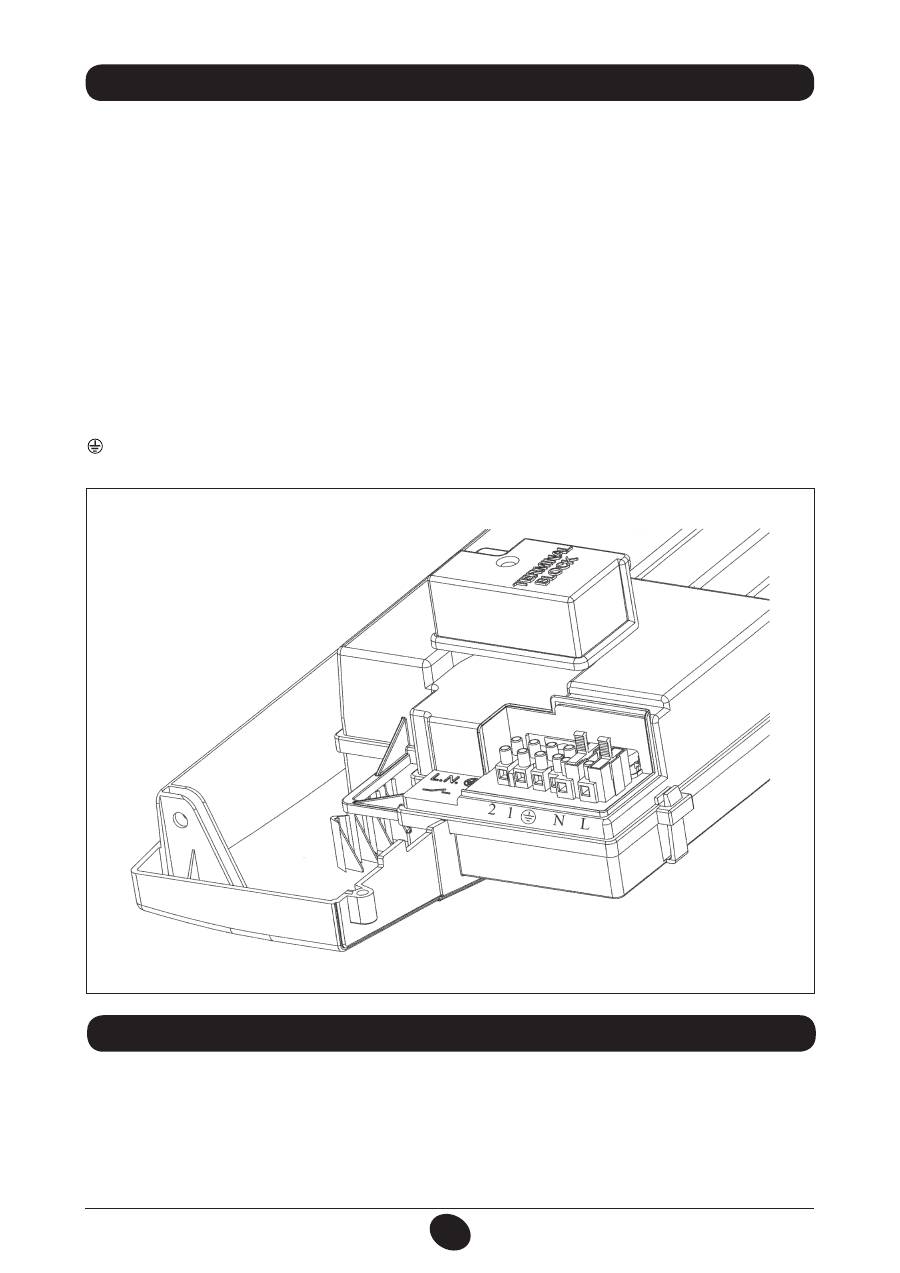
72
71.06199.02 - EN
INSTALLATION INSTRUCTIONS
17. ELECTRICAL CONNECTIONS 18. CONNECTING THE ROOM THERMOSTAT
• Access the power supply terminal block (figure 9) as described in the previous section;
• remove the jumper on terminals (1) and (2);
• thread the two-wire cable through the grommet and connect it to these two terminals.
This machine is only electrically safe if it is correctly connected to an efficient earth system in compliance with current
safety regulations.
Connect the boiler to a 230V single-phase earthed power supply using the supplied three-pin cable, observing correct
LIVE-NEUTRAL polarity.
Use a double-pole switch with a contact separation of at least 3 mm
. When replacing the power supply cable, fit a
harmonised HAR H05 VV-F’ 3x0.75mm
2
cable with a maximum diameter of 8 mm.
…Access to the power supply terminal block
• disconnect the boiler from the mains power supply using the two-pole switch;
• remove the two screws fixing the control panel to the boiler;
• rotate the control panel;
• remove the cover and access the wiring area (figure 9).
The 2A fast-blowing fuse is incorporated in the power supply terminal block (to check and/or replace the fuse, pull out
the black fuse carrier).
IMPORTANT:
respect polarity
L
(LIVE) -
N
(NEUTRAL).
(L) =
Live
(brown)
(N) =
Neutral
(blue)
=
Earth
(yellow-green)
(1) (2) =
Contact for room thermostat
Figure 9
CG_1853 / 1103_2302
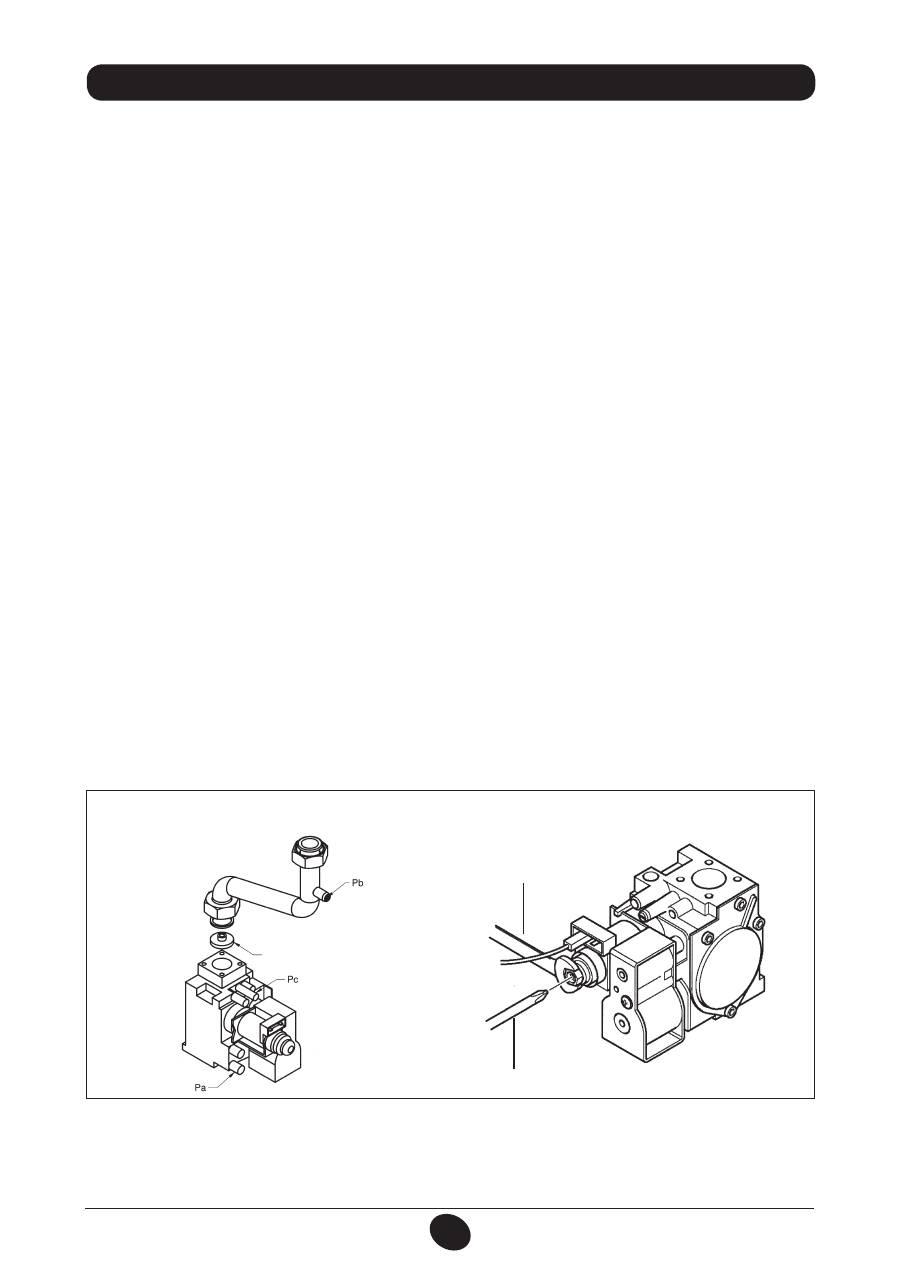
73
71.06199.02 - EN
INSTALLATION INSTRUCTIONS
19. GAS CONVERSION
The authorised Technical Assistance Service can convert this boiler to natural gas (
G. 20
) or liquid gas (
G.31
).
Carry out the following operations:
A) replace the nozzles of the main burner and the gas diaphragm (if fitted);
B) new max. and min. calibration of the pressure regulator.
A) Replace the burner nozzles
• carefully pull the main burner off its seat;
• replace the main burner nozzles making sure to fully tighten them to prevent gas leaks. Nozzle diameters are specified
in table 2.
• replace the gas membrane located on the gas valve (figure 10). The diameter of the membrane is specified in table 2.
Attention:
it is not necessary to change parameter F02.
B) Calibrate the pressure regulator
• connect the positive pressure test point of a differential pressure gauge (possibly water-operated) to the gas valve
pressure test point (
Pb
) (Figure 10). Only for models with sealed chambers, connect the negative pressure test point of
the manometer to a “T” fitting in order to join the boiler adjustment outlet, the gas valve adjusting outlet (Pc) and the
pressure gauge. (The same measurement can be made by connecting the pressure gauge to the pressure test point
(
Pb
) after removing the front panel of the sealed chamber);
Measuring burner pressure using methods other than those described could lead to incorrect results as the low pressure
created by the fan in the sealed chamber would not be taken into account.
B1) Adjustment to nominal heat output:
• open the gas tap and switch the boiler to the Winter mode;
• take the boiler to maximum power as described in section 19.1;
• remove the modulator cover;
• adjust the tube brass screw (a) until the pressure values shown in table 1 are obtained;
• make sure that the dynamic inlet pressure of the boiler, measured at the gas valve pressure test point (Pa) (Figure 10)
is correct (37 mbar for propane or 20 mbar for natural gas).
B2) Adjustment to reduced heat output:
• disconnect the modulator power cable and unscrew the screw (b) until a pressure value corresponding to reduced heat
output is achieved (see tab. 1);
• reconnect the cable;
• mount the modulator cover and seal.
B3) Final checks
• attach the additional plate supplied with the transformer, specifying the type of gas and the calibration performed.
ATTENTION
If the natural gas inlet pressure is too low (less than 17 mbar) remove the gas diaphragm installed over the gas valve (fig.
10) and set parameter
F02=00
on the electronic board (§21).
Figure 10
gas valve
mod. SIGMA 845
b
a
0605_1502
Figure 11
gas diaphragm
CG_2347 / 1104_0406
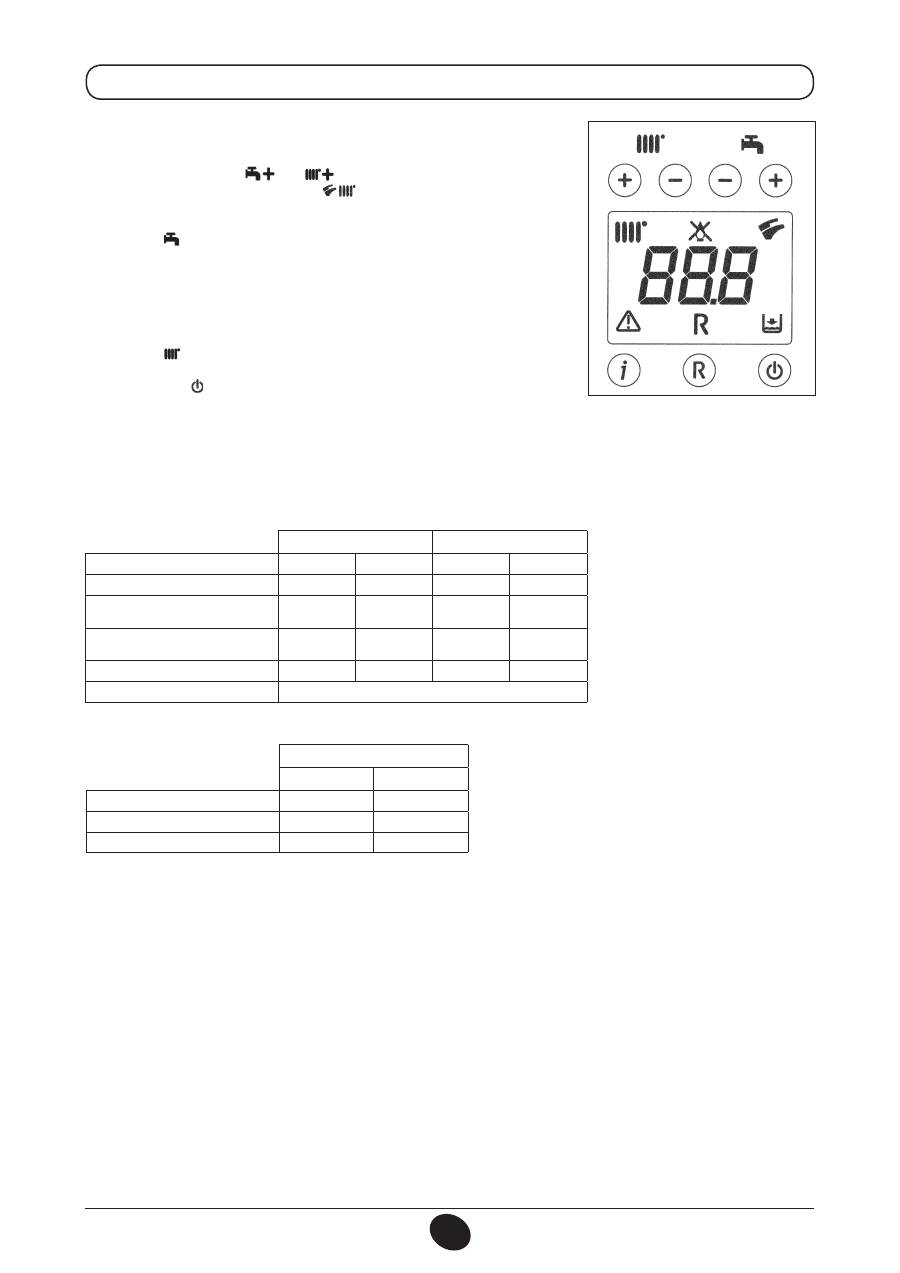
74
71.06199.02 - EN
INSTALLATION INSTRUCTIONS
19.1 GAS VALVE CALIBRATION FUNCTION
Note:
The function is automatically deactivated after a period of 15 minutes, at the end of which the electronic board returns to
its operating status prior to the activation of the function or prior to reaching the set maximum temperature.
To simplify calibration of the gas valve, the calibration function may be set directly
on the boiler control panel as follows:
a)
hold down the buttons
and
together for at least 6 seconds;
b)
after about 6 seconds, the symbols
flash;
c)
the display shows, at intervals of one second, “
100
” and the
flow temperature
.
In this phase, the boiler works at the maximum heating output (100%).
d)
press
+/-
to immediately set the power of the boiler (100% or 0%);
e)
adjust the
“Pmax/Pmin”
screw (figure 10) to set the burner pressure value as
described in table 1.
To adjust pressure at maximum power, turn the “
Pmax
” screw (fig. 10) clockwise
to increase or anti-clockwise to decrease pressure at the burner.
To adjust pressure at minimum power, turn the “
Pmin
” screw (fig. 10) clockwise
to increase or anti-clockwise to decrease pressure at the burner.
f)
press
+/-
to gradually set the desired power level (interval = 1%).
Press the button to leave the function.
0805_2302 / 1002_1201
Consumption 15°C-1013 mbar
24 BIC FF - 24 BIC
G20
G31
Rated power
2,73 m
3
/h
2,00 kg/h
Reduced power
1,26 m
3
/h
0,92 kg/h
p.c.i.
34,02 MJ/m
3
46,34 MJ/kg
Table 2
* 1 mbar = 10,197 mmH
2
O
Table of burner nozzles
24 BIC FF
24 BIC
gas type
G20
G31
G20
G31
diameter of nozzles (mm)
1,18
0,69
1,18
0,69
Burner pressure (mbar*)
REDUCED HEAT OUTPUT
1,7
6,9
1,6
6,6
Burner pressure (mbar*)
RATED HEAT OUTPUT
7,8
24,7
7,5
18,1
Diameter of gas diaphragm (mm)
4,2
3,5
4,2
3,5
N° nozzles
18
Table 1

75
71.06199.02 - EN
INSTALLATION INSTRUCTIONS
20. VISUALISATION OF PARAMETERS ON THE DISPLAY (“INFO” FUNCTION)
Press “
i
” for at least 5 seconds to visualise certain boiler information on the display on the front panel of the boiler.
•
Press buttons (
+/-
) to display the following information:
A00:
current DHW temperature (°C);
A01:
current external temperature (°C) (with external sensor connected);
A02:
modulation current value (100% = 310 mA);
A03:
power range (%) (MAX R);
A04:
heating setpoint temperature (°C) - - If the external sensor is connected, the value of the “
kt
” curve is displayed
(section 26);
A05:
current heating delivery temperature (°C);
A06:
DHW temperature setpoint (°C);
A07:
— — ;
A08:
value (l/minx10) of the DHW flow rate;
A09:
last error that occurred in the boiler.
•
This function remains active for 3 minutes. It is possible to interrupt the “INFO” function in advance by pressing button
(
i
) for at least 5 seconds, or turning off the power to the boiler.
N.B:
when the “INFO” function is enabled, the message “A00”, alternating with the boiler delivery temperature,
is shown on the display (figure 12):
0605_2204 / CG_1808
Figure 12
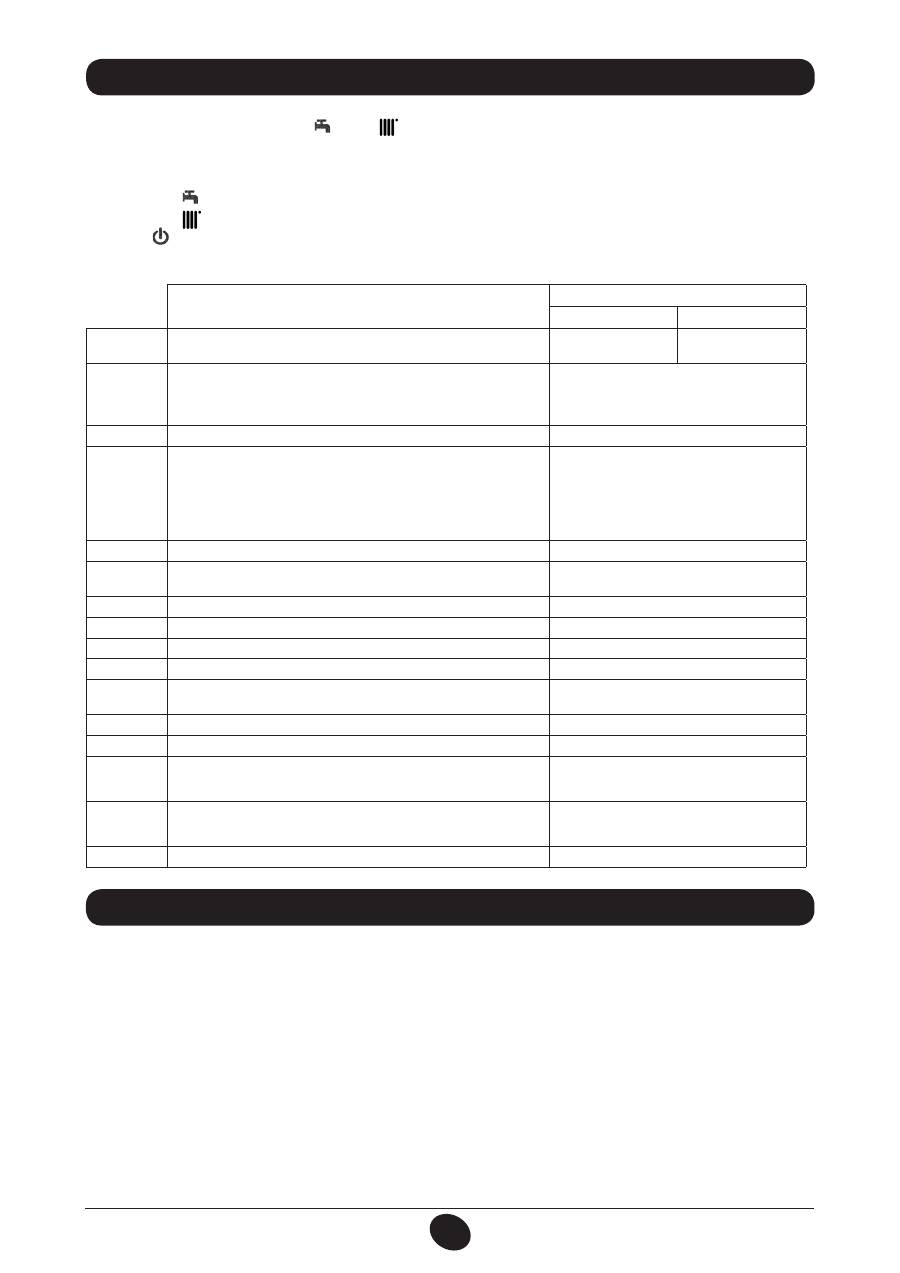
76
71.06199.02 - EN
INSTALLATION INSTRUCTIONS
Description of parameters
Factory settings
24 BIC FF
24 BIC
F01
Type of boiler
10
= sealed chamber
20
= atmospheric chamber
10
20
F02
Gas used
00
= METHANE
01
= LPG
02
= METHANE (WITH DIAPHRAGM)
02
F03
Hydraulic system
15
F04
Setting programmable relay 1 (See SERVICE instructions)
00
= no associated function
01
= condominium alarm
02
= ambient fan
03
= not used
04
= zone pump controlled by room thermostat (230V)
05
= not used
04
F05
Setting programmable relay 2 (DHW pump)
03
F06
Maximum CH setpoint (°C)
00
= 85°C -
01
= 45°C (function unavailable)
00
F07
DHW inlet priority configuration
00
F08
CH max. output
(0-100%)
100
F09
DHW max. output
(0-100%)
100
F10
Min. heating output
(0-100%)
00
F11
Delay prior to new ignition in CH mode
(00-10 minutes) - 00=10 seconds
03
F12
Diagnostics (See SERVICE Instructions)
--
F13-F14-F15
Factory settings (no change)
00
F16
Anti-legionella function
00
= disabled
55...67
= enabled (setpoint °C)
00
F17
CH pressure sensor selection
00
= hydraulic pressure sensor
01
= hydraulic differential pressure sensor
00
F18
Manufacture information
00
21. PARAMETER SETTINGS
To set the boiler parameters, press (
–
) and (
–
) together and hold down for at least 6 seconds. When the function is
activate, the “
F01
” appears on the display alternating with the value of the parameter shown.
Edit parameters
• Press (
+/–
) to scroll through the parameters;
• Press (
+/–
) to edit each parameter;
• Press
(
)
, to save the changes. “
MEM
” appears on the display;
• Press
(
i
)
,
to exit without saving. “
ESC
” appears on the display.
22. ADJUSTMENT AND SAFETY DEVICES
The boiler has been designed in full compliance with European reference standards and in particular is fitted with the
following:
• Air pressure switch (model 24
BIC FF)
This device only allows the burner to ignite if the exhaust flue duct is in perfect working order.
In the event of one or more of the following faults:
• flue terminal obstructed
• venturi tubes obstructed
• fan blocked
• venturi tube connection - pressure switch tripped
the boiler remains on standby and error code E03 is displayed (see table in section 10).
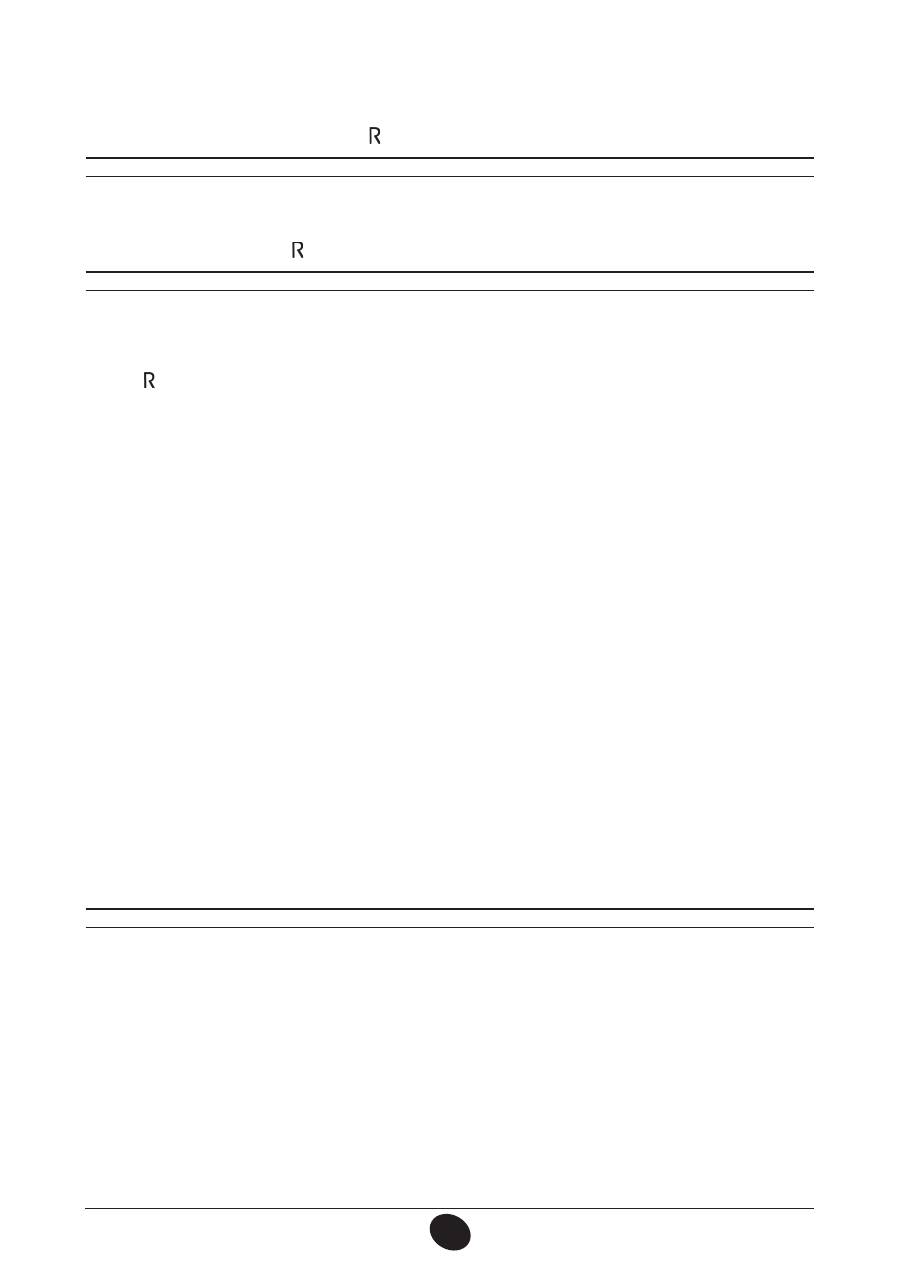
77
71.06199.02 - EN
INSTALLATION INSTRUCTIONS
• Fumes thermostat (model 24
BIC)
This device has a sensor positioned on the left section of the fumes hood and shuts off the gas flow to the main burner
if the flue is obstructed and/or if there is no draught.
In these conditions the boiler shuts down and displays error code E03 (section 10).
After eliminating the problem, press button ( ), for at least 2 seconds to re-ignite immediately.
It is forbidden to disable this safety device
• Safety thermostat
Thanks to a sensor placed on the CH flow line, this thermostat interrupts the flow of gas to the burner if the water in
the primary circuit overheats. In these conditions, the boiler is blocked and only after the fault has been eliminated can
it be ignited again by pressing ( ), for at least 2 seconds.
It is forbidden to disenable this safety device
• Flame ionization detector
The flame sensing electrode, located on the right-hand side of the burner, guarantees safety of operation in case of gas
failure or incomplete ignition of the burner.
In these conditions, the boiler is blocked after 3 ignition attempts.
Press ( ), for at least 2 seconds to re-establish normal operating conditions.
• Hydraulic pressure switch
This device allows the main burner to be ignited only if system pressure is higher than 0.5 bars.
• Pump overrun for heating circuit
The electronically-controlled pump post-circulation function lasts 180 seconds and is enabled, in the heating mode, if
the ambient thermostat causes the burner to go out.
• Pump overrun for DHW circuit
The electronically-controlled pump post-circulation function lasts 30 seconds and is enabled, in the DHW mode, if the
probe causes the burner to go out.
• Frost protection device (CH and DHW systems)
The electronic boiler management system includes a “frost protection” function for the heating system which, when
delivery temperature falls below 5°C, operates the burner until a delivery temperature of 30°C is reached.
This function is enabled when the boiler is switched on, the gas supply is open and the system is correctly pressurised.
• Water not circulating in primary circuit (pump probably blocked)
If there is insufficient or no water circulating in the primary circuit, the boiler blocks and the error code E25 is shown on
the display (section 10).
• Anti-block pump function
If no heat demand is received for 24 consecutive hours, in the heating mode, the pump will automatically start and
operate for 10 seconds. This function is operative when the boiler is powered.
• Three-way valve anti-blockage function
If no heat demand is received for a period of 24 hours, the three-way valve performs a complete switching cycle. This
function is operative when the boiler is powered.
• Hydraulic safety valve (heating circuit)
This device is set to 3 bar and is used for the heating circuit
.
Connect the safety valve to a drain trap. Do not use it to drain the heating circuit.
N.B.:
domestic hot water is guaranteed even if the NTC sensor develops a fault. In this case, temperature is controlled
by the delivery sensor.
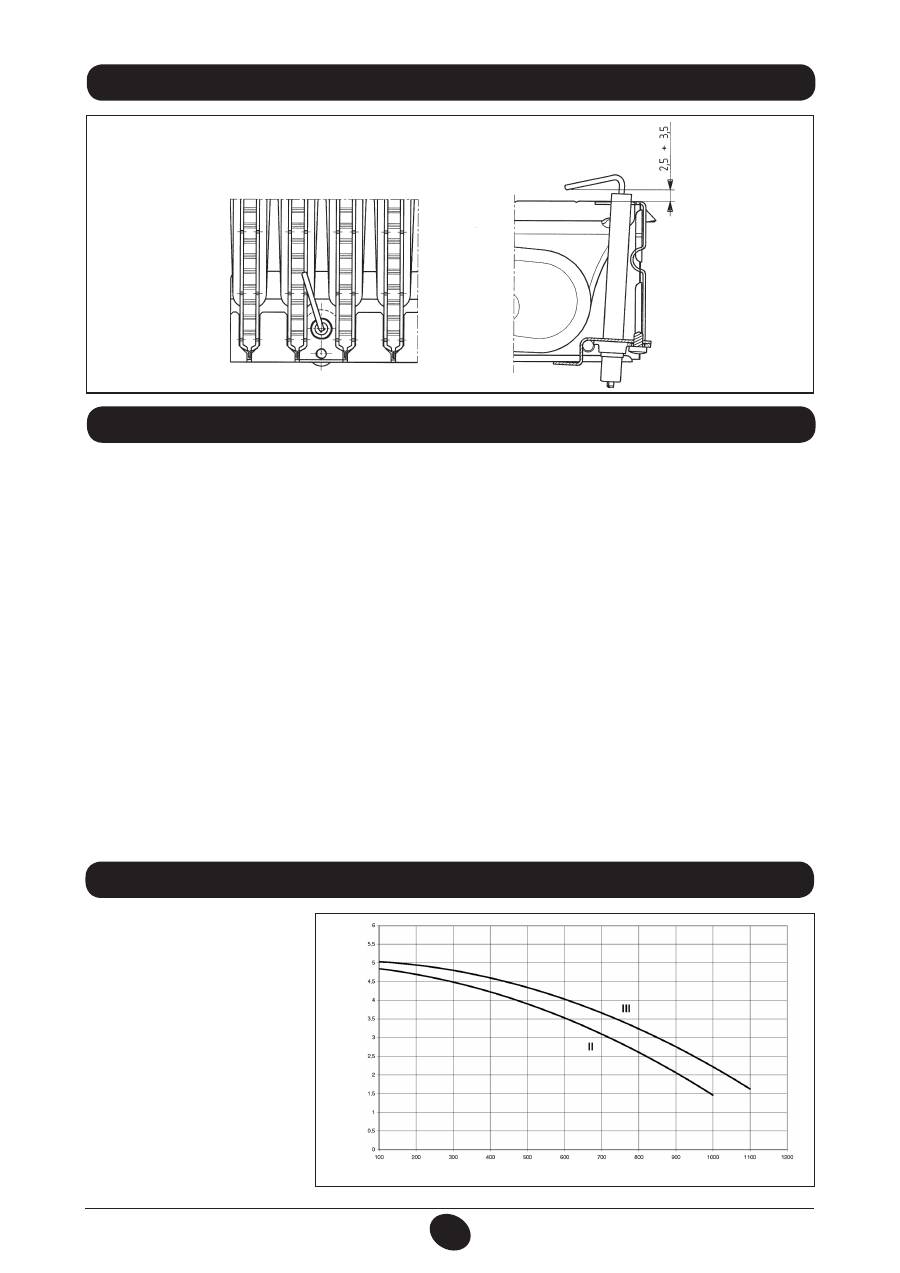
78
71.06199.02 - EN
INSTALLATION INSTRUCTIONS
To measure combustion efficiency and the toxicity of the products of combustion, the boiler is fitted with two dedicated
test points.
One connection point is connected to the exhaust duct and is used to measure combustion efficiency and the toxicity of
the products of combustion.
The other is connected to the air intake circuit and is used to check for the presence of any products of combustion
circu¬lating in installations with co-axial flues.
The following parameters can be measured using the test point connected to the exhaust duct:
• temperature of the products of combustion;
• concentration of oxygen (O
2
) or, alternatively, carbon dioxide (CO
2
);
• concentration of carbon monoxide (CO).
The temperature of the comburent air must be measured on the test point located on the air intake flue by inserting the
measurement sensor by about 3 cm.
N.B.:
to regulate the rated power, see chapter 19 (B1)
For natural draught boiler models, a hole must be made in the exhaust flue at a distance from the boiler equal to twice
the internal diameter of the flue.
The following parameters can be measured through this hole:
• temperature of the products of combustion;
• concentration of oxygen (O
2
) or, alternatively, carbon dioxide (CO
2
);
• concentration of carbon monoxide (CO).
The temperature of the combustion air must be measured close to the point where the air enters the boiler. The hole,
which must be made by the person in charge of the system during commissioning, must be sealed so as to ensure that
the exhaust duct is airtight during normal operation.
24. CHECKING COMBUSTION PARAMETERS 25. PUMP CAPACITY/ HEAD
A high static head pump (GRUN-
DFOS UPSO 15-50), suitable for
installation on any type of single- or
double-pipe heating system, is used.
The automatic air valve incorporated
in the pump allows quick venting of
the heating system.
Graph 1
FLOW l/h
HEAD mH
2
O
1103_0901
23. POSITIONING THE IGNITION AND FLAME-SENSING ELECTRODE
Figure 13
9912070100
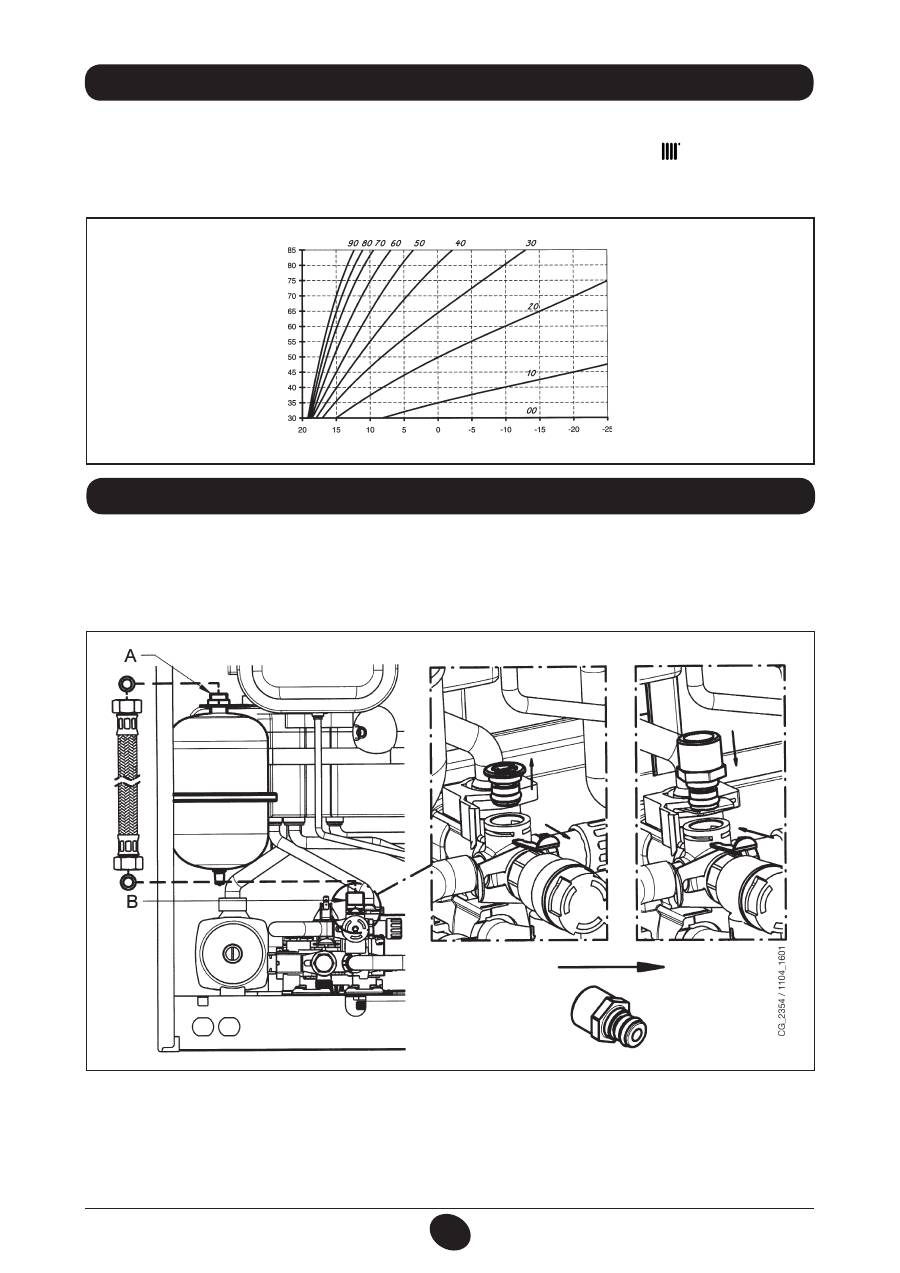
79
71.06199.02 - EN
INSTALLATION INSTRUCTIONS
26. CONNECTING THE EXTERNAL SENSOR
The wiring harness leaving the control board includes two RED wires fitted with faston covers. Connect the external sensor
to these two wires.
With the external sensor connected, the “
kt
” curve (Graph 2) can be changed by pressing
+/-
.
N.B.: In case of installation in an average living unit (good perimeter insulation and radiator systems), set the “
kt
” climate
curve to “25”.
TM
= Flow temperature range
Te
= External temperature
Graph 2
TM
Te
“kt” curves
1012_0501
DHW expansion vessel kit comprising:
- 1 stainless steel expansion vessel;
- 1 support for expansion vessel;
- 1 nipple G1/2”;
- 1 lock nut;
- 1 connection hose.
27. DHW EXPANSION VESSEL (AVAILABLE ON REQUEST)
Connect the hose (supplied as an accessory in the expansion vessel kit) to the two connectors A and B as shown in figure.
The DHW expansion vessel should be mounted if:
- the pressure of the water supply or lifting system is such as to require the installation of a pressure reducer (pressure
higher than 4 bar)
- a non-return valve is fitted to the water supply line
- the water supply network is insufficient for the expansion of the water contained in the storage boiler and it is necessary
to use the DHW expansion vessel.
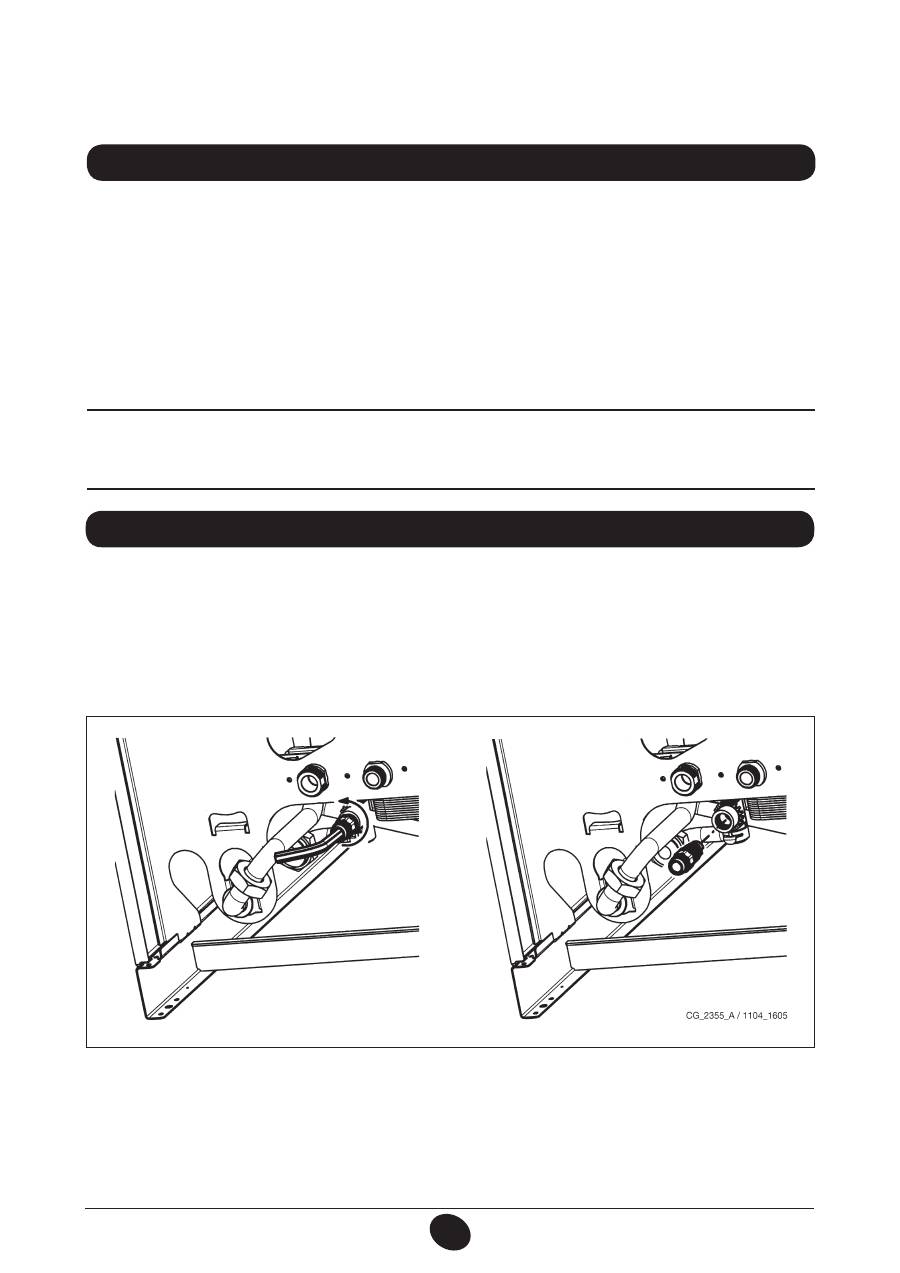
80
71.06199.02 - EN
INSTALLATION INSTRUCTIONS
To optimise boiler efficiency, carry out the following annual controls:
• check the appearance and air-tightness of the gaskets of the gas and combustion circuits;
• check the state and correct position of the ignition and flame-sensing electrodes;
• check the state of the burner and make sure it is firmly fixed;
• check for any impurities inside the combustion chamber.
Use a vacuum cleaner to do this;
• check the gas valve is correctly calibrated;
• check the pressure of the heating system;
• check the pressure of the expansion vessel;
• check the fan works correctly;
• make sure the flue and air ducts are unobstructed.
• check the state of the boiler anode.
WARNINGS
Before commencing any maintenance operations, make sure the boiler is disconnected from the power supply.
Afterwards, move the knobs and/or operating parameters of the boiler to their original positions.
28. ANNUAL SERVICE
TIPS
For the efficient operation of the expansion vessel, the pressure of the water supply must be lower than 4 bar. If it is not,
install a pressure reducer. Adjust the pressure reducer to obtain a water supply pressure less than 4 bar.
DRAINING THE BOILER CIRCUIT
Drain the boiler by opening the tap in the hydraulic assembly.
To drain the boiler using the drain tap located at the bottom, proceed as follows (fig. 14):
- close the boiler on/off valves;
- open the drain tap using an 8 mm hex wrench;
- drain the boiler;
- close the drain tap using the 8 mm hex wrench.
29. DRAINING THE BOILER CIRCUIT AND THE STORAGE BOILER
Figure 14

